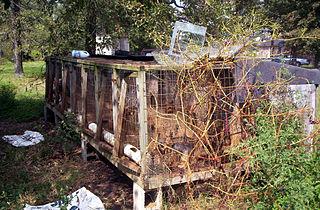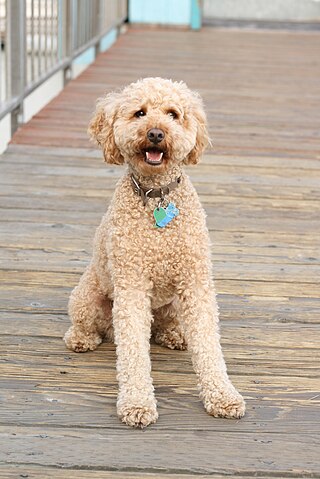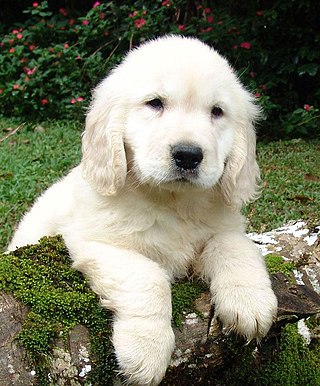
The American Kennel Club (AKC) is a registry of purebred dog pedigrees in the United States. In addition to maintaining its pedigree registry, this kennel club also promotes and sanctions events for purebred dogs, including the Westminster Kennel Club Dog Show, an annual event which predates the official forming of the AKC, the National Dog Show and the AKC National Championship. The AKC is a non-member partner with the Fédération Cynologique Internationale. The AKC recognizes 200 dog breeds, as of 2022.

The Pomeranian is a breed of dog of the Spitz type that is named for the Pomerania region in north-west Poland and north-east Germany in Central Europe. Classed as a toy dog breed because of its small size, the Pomeranian is descended from larger Spitz-type dogs, specifically the German Spitz.

The Hundred and One Dalmatians is a 1956 children's novel by Dodie Smith about the kidnapping of a family of Dalmatian puppies. It was originally serialized in Woman's Day as The Great Dog Robbery, and details the adventures of two dalmatians named Pongo and Missis as they rescue their puppies from a fur farm. A 1967 sequel, The Starlight Barking, continues from the end of the novel.

An assistance dog, known as a service dog in the United States, is a dog trained to aid or assist an individual with a disability. Many assistance dogs receive training from a handler or from an assistance dog organization.

A puppy mill, also known as a puppy farm, is a commercial dog breeding facility characterized by quick breeding and poor conditions. Although no standardized legal definition for "puppy mill" exists, a definition was established in Avenson v. Zegart in 1984 as "a dog breeding operation in which the health of the mill’s dogs is disregarded to maintain a low overhead and maximize profits". They are cited as being a result of increased demand for household pets, especially after World War II. The Veterinary Medical Association of the Humane Society of the United States defines the main characteristics of a puppy mill as "emphasis on quantity over quality, indiscriminate breeding, continuous confinement, lack of human contact and environmental enrichment, poor husbandry, and minimal to no veterinary care."

A lap dog or lapdog is a dog that is both small enough to be held in the arms or lie comfortably on a person's lap and temperamentally predisposed to doing so. Lapdog is not a specific breed, but a generic term for a type of dog that is small in size and friendly towards humans.

Dog crossbreeds, sometimes called designer dogs, are dogs which have been intentionally bred from two or more recognized dog breeds. They are not dogs with no purebred ancestors, but are not otherwise recognised as breeds in their own right, and do not necessarily breed true.

An obedience school is an institution that trains pets how to behave properly. When puppies are young and in the first stages of training, they are often taken by their owners to obedience schools. Training usually takes place in small groups. In addition to training pets themselves, obedience schools also teach pet owners how to train, praise, and scold their pets themselves. Schools can teach at a various set of levels, ranging from the very basics for puppies to more advanced for competition level dogs. Most training in schools however, focuses on making dogs listen through basic commands such as sit, stay, lie down, etc.

Crate training is the process of training a pet to tolerate confinement in a dog crate or cage. Crate advocates often claim that dogs are "den-dwelling" animals and that a crate can become a "den" substitute and a familiar and safe location for the pet. Most puppies can eventually tolerate crate training if it is introduced properly. The initial stress from being confined can give way to "increased feelings of security, safety, and comfort" after repeated exposure to the crate. Long-term or excessive crate confinement "may lead to emotional and behavioral deterioration over time." On the other hand, if properly done, crate training can play a major role in housebreaking a dog as fast as possible. Confining a dog in a crate or cage restricts its movement and freedom, If crate training is not taken seriously, the dog may start soiling around the house.

A bark is a sound most often produced by dogs. Other animals that make this noise include, but are not limited to, wolves, coyotes, foxes, seals, frogs, and barking owls. "Bark" is also a verb that describes the sound of many canids.

Downward Dog Pose or Downward-facing Dog Pose, also called Adho Mukha Svanasana, is an inversion asana, often practised as part of a flowing sequence of poses, especially Surya Namaskar, the Salute to the Sun. The asana is commonly used in modern yoga as exercise. The asana does not have formally named variations, but several playful variants are used to assist beginning practitioners to become comfortable in the pose.

The dog is a domesticated descendant of the wolf. Also called the domestic dog, it is derived from extinct gray wolves, and the gray wolf is the dog's closest living relative. The dog was the first species to be domesticated by humans. Experts estimate that hunter-gatherers domesticated dogs more than 15,000 years ago, which was before the development of agriculture. Due to their long association with humans, dogs have expanded to a large number of domestic individuals and gained the ability to thrive on a starch-rich diet that would be inadequate for other canids.

A puppy is a juvenile dog. Some puppies can weigh 1–1.5 kg (2.2–3.3 lb), while larger ones can weigh up to 7–11 kg (15–24 lb). All puppies display primary altriciality and healthy puppies grow quickly after birth. A puppy's coat color may change as the puppy grows older, as is commonly seen in breeds such as the Yorkshire Terrier. Puppy refers specifically to young dogs, while pup may be used for other animals such as wolves, seals, giraffes, guinea pigs, rats or sharks.

Bālāsana or Child Pose, is a kneeling asana in modern yoga as exercise. Balasana is a counter asana for various asanas and is usually practiced before and after Sirsasana.

Inubaka: Crazy for Dogs is a Japanese manga series written and illustrated by Yukiya Sakuragi. It started in Shueisha's seinen manga magazine Weekly Young Jump in September 2004 and was later transferred to Monthly Young Jump in August 2009, where it ended in April 2010. Its chapters were collected in 22 tankōbon volumes. The series was licensed in North America by Viz Media, who published 17 volumes from 2007 to 2010, before ceasing its publication. A live-action film adaptation premiered in November 2009.
Dognapping is the crime of taking a dog from its owner. The word is derived from the term kidnapping.
The National Animal Interest Alliance (NAIA) is a non-profit organization in the United States dedicated to promoting animal welfare and animal husbandry practices, strengthening the human-animal bond, and safeguarding the rights of responsible animal owners and professionals through research, public education and public policy. The NAIA mission is "to promote the welfare of animals."
Sarah Wilson is an American author, dog trainer, and international speaker. She is the author of eight books about subjects related to pet ownership.

Yoga in advertising is the use of images of modern yoga as exercise to market products of any kind, whether related to yoga or not. Goods sold in this way have included canned beer, fast food and computers.

















